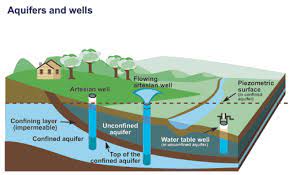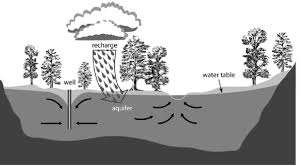Groundwater is the water present beneath Earth’s surface in soil pore spaces and in the fractures of rock formations. A unit of rock or an unconsolidated deposit is called an aquifer when it can yield a usable quantity of water.
The depth at which soil pore spaces or fractures and voids in rock become completely saturated with water is called the water table. Groundwater is recharged from and eventually flows to the surface naturally; natural discharge often occurs at springs and seeps, and can form oases or wetlands.
Groundwater is also often withdrawn for agricultural, municipal, and industrial use by constructing and operating extraction wells. The study of the distribution and movement of groundwater is hydrogeology, also called groundwater hydrology.
Typically, groundwater is thought of as water flowing through shallow aquifers, but, in the technical sense, it can also contain soil moisture, permafrost (frozen soil), immobile water in very low permeability bedrock, and deep geothermal or oil formation water.
Groundwater is hypothesized to provide lubrication that can possibly influence the movement of faults. It is likely that much of Earth’s subsurface contains some water, which may be mixed with other fluids in some instances. Groundwater may not be confined only to Earth.
The formation of some of the landforms observed on Mars may have been influenced by groundwater. There is also evidence that liquid water may also exist in the subsurface of Jupiter’s moon Europa.
Groundwater is often cheaper, more convenient and less vulnerable to pollution than surface water. Therefore, it is commonly used for public water supplies.
Read Also : Health Hazards Associated with Water Treatment
For example, groundwater provides the largest source of usable water storage in the United States, and California annually withdraws the largest amount of groundwater of all the states.
Underground reservoirs contain far more water than the capacity of all surface reservoirs and lakes. Many municipal water supplies are derived solely from groundwater
Aquifers
An aquiferis a layer of porous substrate that contains and transmits groundwater. When water can flow directly between the surface and the saturated zone of an aquifer, the aquifer is unconfined.
The deeper parts of unconfined aquifers are usually more saturated since gravity causes water to flow downward.
The upper level of this saturated layer of an unconfined aquifer is called the watertable or phreaticsurface. Below the water table, where in general all pore spaces are saturated with water, is the phreatic zone.
Substrate with low porosity that permits limited transmission of groundwater is known as an aquitard. An aquiclude is a substrate with porosity that is so low it is virtually impermeable to groundwater.

A confined aquifer is an aquifer that is overlain by a relatively impermeable layer of rock or substrate such as an aquiclude or aquitard.
If a confined aquifer follows a downward grade from its recharge zone, groundwater can become pressurized as it flows.
This can create artesian wells that flow freely without the need of a pump and rise to a higher elevation than the static water table at the above, unconfined, aquifer.
The characteristics of aquifers vary with the geology and structure of the substrate and topography in which they occur. In general, the more productive aquifers occur in sedimentary geologic formations.
By comparison, weathered and fractured crystalline rocks yield smaller quantities of groundwater in many environments. Unconsolidated to poorly cemented alluvial materials that have accumulated as valley-filling sediments in major river valleys and geologically subsiding structural basins are included among the most productive sources of groundwater.
Underground water and aquifers
Aquifers are underground layers of rock that are saturated with water that can be brought to the surface through natural springs or by pumping.
The groundwater contained in aquifers is one of the most important sources of water on Earth: About 30 percent of our liquid freshwater is groundwater, according to the National Oceanic and Atmospheric Administration (NOAA).
The rest is found at the surface in streams, lakes, rivers and wetlands. Most of the world’s freshwater about 69 percent is locked away in glaciers and ice caps.
Read Also : Procedures of Water Quality Analysis
Groundwater can be found in a range of different types of rock, but the most productive aquifers are found in porous, permeable rock such as sandstone, or the open cavities and caves of limestone aquifers.
Groundwater moves more readily through these materials, which allows for faster pumping and other methods of extracting the water.
Aquifers can also be found in regions where the rock is made of denser material such as granite or basalt if that rock has cracks and fractures.
Dense, impermeable material like clay or shale can act as an “aquitard,” i.e., a layer of rock or other material that is almost impenetrable to water.
Through groundwater might move through such material, it will do so very slowly (if at all). Faults or mountains can also block the movement of fresh groundwater,
An aquitard can trap groundwater in an aquifer and create an artesian well. When groundwater flows beneath an aquitard from a higher elevation area to a lower elevation, such as from a mountain slope to a valley floor, the pressure on the groundwater can be enough to force the water out of any well that’s drilled into that aquifer.
Such wells are known as artesian wells, and the aquifers they tap into are called artesian aquifers or confined aquifers.
How groundwater moves
When new surface water enters an aquifer, it “recharges” the groundwater supply. Recharge primarily happens near mountains, and groundwater flows usually flows downward from mountain slopes toward streams and rivers by the force of gravity, Phillips said.
Depending on the density of the rock and soil through which groundwater moves, it can creep along as slowly as a few centimeters in a century, according to Environment Canada. In other areas, where the rock and soil are looser and more permeable, groundwater can move several feet in a day.
The water in an aquifer can be held beneath the Earth’s surface for many centuries: Hydrologists estimate that the water in some aquifers is more than 10,000 years old (meaning that it fell to the Earth’s surface as rain or snow roughly 6,000 years before Egypt’s Great Pyramid of Giza was built).
The oldest groundwater ever found was discovered 2 miles (2.4 km) deep in a Canadian mine and trapped there between 1.5 and 2.64 billion years ago.
But the deeper one digs for water, the saltier the liquid becomes. Groundwater can be very, very deep, but eventually it’s a brine.
Much of the drinking water on which society depends is contained in shallow aquifers. For example, the Ogallala Aquifer a vast, 174,000 square-mile (450,000 square kilometers) groundwater reservoir supplies almost one-third of America’s agricultural groundwater, and more than 1.8 million people rely on the
Threats to aquifers
By 2010, about 30 percent of the Ogallala Aquifer’s groundwater had been tapped, according to a 2013 study from Kansas State University. Some parts of the Ogallala Aquifer are now dry, and the water table has declined more than 300 feet in other areas.
This problem is increasingly found throughout the world, especially in areas where a rapidly growing population is placing greater demand on limited aquifer resources — pumping can, in these places, exceed the aquifer’s ability to recharge its groundwater supplies.
When pumping of groundwater results in a lowering of the water table, then the water table can drop so low that it’s below the depth of a well. In those cases, the well “runs dry” and no water can be removed until the groundwater is recharged — which, in some cases, can take hundreds or thousands of years.
When the ground sinks because of groundwater pumping, it is called subsidence. In California’s southern San Joaquin Valley, where farmers rely on wells for irrigation, the land surface settled 28 feet (8.5 meters) between the 1920s and the 1970s. Land subsidence is a threat to aquifers and also to infrastructure on the surface.
In addition to groundwater levels, the quality of water in an aquifer can be threatened by saltwater intrusion (a particular problem in coastal areas), biological contaminants such as manure or septic tank discharge, and industrial chemicals such as pesticides or petroleum products. And once an aquifer is contaminated, it’s notoriously difficult to remediate.
In conclusion, underground water and aquifers are very important source of water for man, agricultural practices and livestock. Aquifers ensure supply of water even in very arid conditions.

